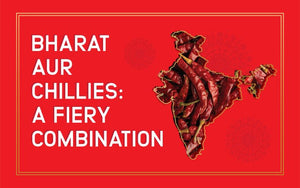India's Fiery Passion: A Tale of Chillies

Mar 27, 2024
In the vibrant mosaic of Indian cuisine, there's one ingredient that reigns supreme, adding heat, depth, and complexity to every dish: the humble yet mighty chilli. From the bustling streets of Mumbai to the serene backwaters of Kerala, chillies have woven themselves into the fabric of Indian culinary heritage, leaving an indelible mark on the nation's palate and culture. Join us as we embark on a spicy journey through the diverse world of Indian chillies, exploring their rich history, distinctive flavors, and culinary significance.
The Spice that Ignited a Revolution
Believed to have been introduced to India by Portuguese traders in the 15th century, chillies quickly captured the imagination of Indian cooks, transforming the culinary landscape with their fiery heat and bold flavor. Originally cultivated in the Americas, chillies found an ideal home in the tropical climate of India, where they flourished and proliferated, becoming an integral part of the local cuisine.
Ten Varieties of Indian Chillies
Bhut Jolokia (Ghost Pepper): Hailing from the northeastern state of Assam, Bhut Jolokia holds the title of one of the hottest chillies in the world. Its intense heat is tempered by fruity undertones, making it a popular choice for adding fiery flavor to pickles and chutneys.
Kashmiri Chilli: Known for its vibrant red hue and mild heat, Kashmiri chilli is a staple in Kashmiri cuisine, lending its rich color and subtle spiciness to dishes like Rogan Josh and Yakhni.
Byadgi Chilli: Grown in the fertile plains of Karnataka, Byadgi chilli boasts a deep red color and moderate heat. Its unique flavor profile, with hints of smokiness and sweetness, makes it a favorite for South Indian dishes like sambar and rasam.
Guntur Chilli: Named after the city of Guntur in Andhra Pradesh, this chilli variety is prized for its fiery heat and pungent aroma. It is commonly used in Andhra cuisine to add heat and flavor to dishes like biryani and curries.
Naga Viper Chilli: Another fiery contender from the northeastern region of India, Naga Viper chilli combines intense heat with floral and citrusy notes. It is often used sparingly in pickles and hot sauces for a potent kick.
Dhaniya Mirch (Coriander Chilli): A staple in North Indian cooking, Dhaniya Mirch is a blend of dried coriander seeds and green chillies. It adds a fragrant, herbaceous flavor and mild heat to dishes like sabzis and dals.
Bhoot Jhalokia (King Chilli): Native to the hilly regions of Manipur, Bhoot Jhalokia is prized for its searing heat and fruity undertones. It is often used in traditional Manipuri dishes like Eromba and Chak-hao Kheer.
Sankeshwari Chilli: Grown in the arid plains of Maharashtra, Sankeshwari chilli is known for its bright red color and medium heat. It is a key ingredient in Maharashtrian dishes like Misal Pav and Kanda Bhaji.
Bird's Eye Chilli: Also known as Kanthari Mulaku in Malayalam, Bird's Eye Chilli is popular in South Indian cuisine for its intense heat and sharp, peppery flavor. It is often used in dishes like fish curry and thoran.
Teja Chilli: Named after the Teja region in Andhra Pradesh, Teja chilli is prized for its fiery heat and vibrant red color. It is commonly used in the preparation of spicy Andhra pickles and powders.
Conclusion: A Spicy Symphony of Flavor
From the fiery heat of the Bhut Jolokia to the subtle sweetness of Kashmiri chilli, Indian chillies offer a kaleidoscope of flavors and sensations that delight the senses and ignite the imagination. Whether used as a fiery accent or a subtle undertone, chillies are an essential ingredient in the tapestry of Indian cuisine, adding depth, complexity, and a touch of heat to every dish. At Manpras Spices, we celebrate the diversity and richness of Indian chillies, offering you the finest selection of premium varieties to elevate your culinary creations and embark on your own spicy adventures.
